- Kids Preschool
- About Blocks ( 막기 makgi )
- Cross Block ( 엇걸어막기 otgoreo-makgi )
Taekwondo 태권도Taekwondo Preschool
Promotion from one geup to the next can proceed rapidly in some schools, since schools often allow geup promotions every two, three, or four months. Students of geup rank learn the most basic techniques first, and then move on to more advanced techniques as they approach first dan. Many of the older and more traditional schools often take longer to allow students to test for higher ranks than newer, more contemporary schools, as they may not have the required testing intervals. View Taekwondo belt levels »

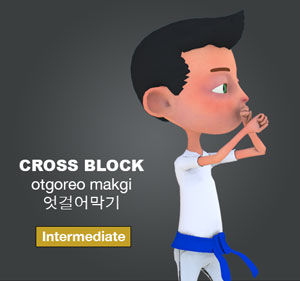
Cross Block
( 엇걸어막기 otgoreo-makgi )
Difficulty Level: Intermediate Technique: Blocks ( 막기 makgi )
The Cross Block ( 엇걸어막기 otgoreo-makgi ) is when the practitioner crosses their hands to block ( 막기 makgi ) an attack. This block ( 막기 makgi ) technique starts near the waist on the opposite side of the foot in front. The hand that is on the same side as the foot in front should be under the other hand. Cross your wrists ( 팔목 palmok ) and finish by placing your hands in the center blocking either the low- or high-section. Remember with both arms and hands in front that your visibility is partially blocked. This intermediate block ( 막기 makgi ) is also known as the X-Block in taekwondo and other martial arts.
Practitioners should generally exhale as the block ( 막기 makgi ) nears the strike. Breath control is important to relax the body when not blocking; novice practitioners often waste significant energy because they are tense at inappropriate times.
Experienced practitioners learn through repetition and muscle memory when (not just how) to launch particular blocks ( 막기 makgi ), based on the circumstances they are facing. Fights and fighters may have ebbs and flows in momentum and action that become predictable. Disrupting this flow may give the striker an advantage.
* Please see a certified Master Instructor ( 사범님 sabeomnim ) for training. Proper guidance and instructions are needed to ensure safe training.
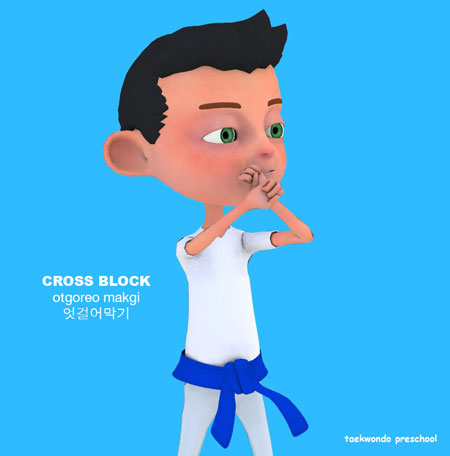
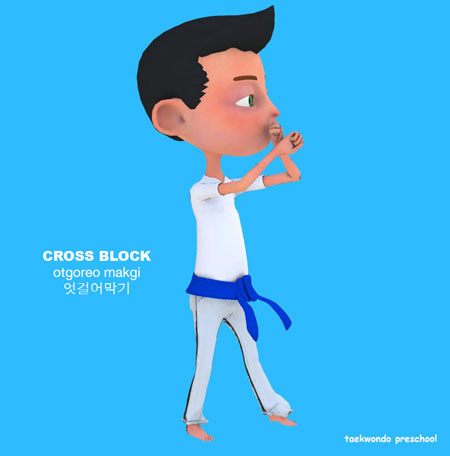
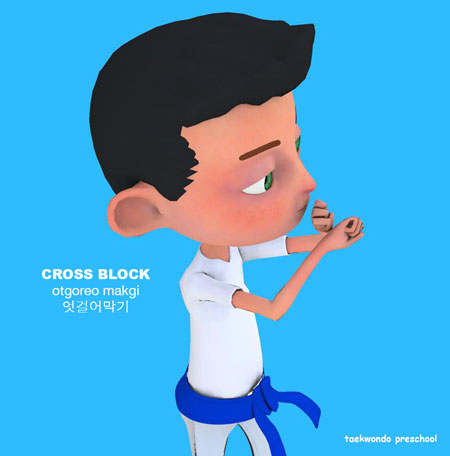


Did you know?
Impact Surface Area
Various surfaces of the body may be engaged as the blocking and striking surface depending on which area of the body is being targeted. This leads to a large array of blocking and striking positions. More information on Impact Surface Areas »
| Surface | Korean | Description | Tutorial | |
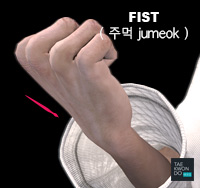 |
Fist ( 주먹 jumeok ) - is an action where a hand has the fingers curled into the palm and the thumb retracted, displaying the knuckles. |
주먹 jumeok | A fist ( 주먹 jumeok ) is an action where a hand has the fingers curled into the palm and the thumb retracted, displaying the knuckles. The act of creating a fist is known as 'making a fist' or 'clenching a fist'. | Tutorial » |
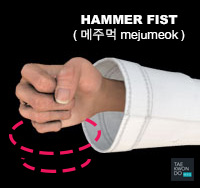 |
Hammer Fist ( 메주먹 mejumeok ) - is an action where a hand has the fingers curled into the palm and the thumb retracted, using the bottom of the hand as the striking surface. |
메주먹 mejumeok | A Hammer Fist is an action where a hand has the fingers curled into the palm and the thumb retracted, using the bottom of the hand as the striking surface. The act of creating a fist ( 주먹 jumeok ) is known as 'making a fist' or 'clenching a fist'. | Tutorial » |
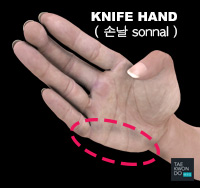 |
Hand Blade ( 손날 sonnal ) - striking surface extends with the muscle at the side of the hand located between the base of the small finger and the wrist. |
손날 sonnal | By tucking the thumb into the palm, a striking surface called the knife hand or hand blade ( 손날 sonnal ) is formed. The striking surface extends with the muscle at the side of the hand located between the base of the small finger and the wrist. | Tutorial » |
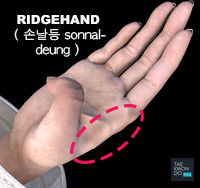 |
Ridgehand ( 손날등 sonnal-deung ) - reverse knife-hand is formed, extending a few inches along the inside of the hand below the first knuckle of the index finger. |
손날등 sonnal-deung | By tucking the thumb into the palm, a striking surface called the ridgehand ( 손날등 sonnal-deung ), or reverse knife-hand is formed, extending a few inches along the inside of the hand below the first knuckle of the index finger. | Tutorial » |
RESOURCES
This article uses material from the Wikipedia articles "Hand", "Fist (hand)", "Knife Hand", which is released under the Creative Commons Attribution-Share-Alike License 3.0.

Quiz
Question. What is the korean terminology for Blocking?
In martial arts, blocking is the act of stopping or deflecting an opponent's attack for the purpose of preventing injurious contact with the body. A block usually consists of placing a limb across the line of the attack. Blocks are considered by some to be the most direct and least subtle of defensive techniques.
Question. What is the korean terminology for blocking?
Answer you gave was: ( 지르기 jireugi )
Your answer is wrong! You need to study more!
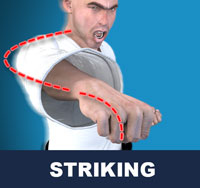

Taekwondo Fist Strikes ( 지르기 jireugi ) are performed as a close distance alternative to kicks ( 차기 chagi ). They are executed in a number of ways - from standing, jumping, spinning and rushing forwards. The striker relaxes to the extent possible during the strike, tensing the muscles of much of the body only at the time of impact, then relaxing again to recoil the striking part. Hand strikes make up fast combinations of strikes which can leave an opponent stunned and unable to defend himself most commonly in self defense ( 호신술 hosinsool ) applications.
Question. What is the korean terminology for blocking?
Answer you gave was: ( 서기 sogi )
Your answer is wrong! You need to study more!


The Korean martial arts has several Stances ( 서기 sogi ) used for different activities. Although there are strong similarities in stances throughout taekwondo schools, individual instructors often have their own preferred style. These stances are most commonly seen in taekwondo forms, and are critical for balance, precision, and good technique in the martial art.
Question. What is the korean terminology for blocking?
Answer you gave was: ( 막기 makgi )
Your answer is correct! Great Job!
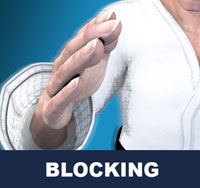

In martial arts, blocking ( 막기 makgi ) is the act of stopping or deflecting an opponent's attack for the purpose of preventing injurious contact with the body. A block ( 막기 makgi ) usually consists of placing a limb across the line of the attack. Blocks ( 막기 makgi ) are considered by some to be the most direct and least subtle of defensive techniques.
Question. What is the korean terminology for blocking?
Answer you gave was: ( 치기 chigi )
Your answer is wrong! You need to study more!
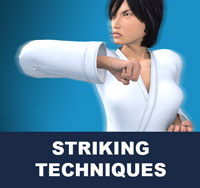

Taekwondo Strikes ( 치기 chigi ) are performed as a close distance alternative to kicks. Hand strikes make up fast combinations of strikes which can leave an opponent stunned and unable to defend himself. Striking ( 치기 chigi ) are taekwondo techniques striking with the twisting force of the body excluding techniques using the fist ( 주먹 jumeok ) or fingertips ( 손끝 sonkkeut ).
Question. What is the name of Taegeuk #4 in Korean?
Taegeuk 태극 (in World Taekwondo (WT)) refers to a set of poomse 품새 used to create a foundation for the teaching of taekwondo. A poomse or form is a detailed pattern of defense-and-attack motions and techniques used in traditional martial arts. Each taegeuk form symbolizes a specific state thought to be indicative of the belt the student currently holds, and is represented in World Taekwondo (WT) by trigrams similar to those found in the four corners of the South Korean flag.
Question. What is the name of Taegeuk #4 in Korean?
Answer you gave was: O Jang
Your answer is wrong! You need to study more!


The trigram associated with this poomse represents Wind. The trigram is also related to southwest and the relationship with an eldest daughter. The I Ching promotes that wind is a gentle force, but can sometimes be furious, destroying everything in its path. As such, it is intended that this poomse is performed like the wind: gently, but knowing the ability of mass destruction with a single movement.
Question. What is the name of Taegeuk #4 in Korean?
Answer you gave was: Sam Jang
Your answer is wrong! You need to study more!


This trigram represents Fire. Related to this symbol is also East and the relationship of the Second Daughter. Fire contains a lot of energy. The symbol behind the fire is similar to the symbolism of the water in that both can aid and both can destroy. This form is intended to be performed rhythmically, with some outbursts of energy to reflect fire's rhythmic and energetic dualism.
Question. What is the name of Taegeuk #4 in Korean?
Answer you gave was: Sa Jang
Your answer is correct! Great Job!


This trigram represents Thunder. Also, the trigram is strongly connected to northeast and the relationship of the Eldest son. Thunder comes from the sky and is absorbed by the earth, thus, according to the beliefs of the I Ching, thunder is one of the most powerful natural forces. This poomse is associated with power and the connection between the heavens and earth.
Question. What is the name of Taegeuk #4 in Korean?
Answer you gave was: Il Jang
Your answer is wrong! You need to study more!


The general meaning of this form and associated trigram is Yang, which represents Heaven and Light. Also, this trigram has a relationship to South and Father. The first Taegeuk form is the beginning of all poomses, the "birth" of the martial artist into Taekwondo. This poomse should be performed with the greatness of Heaven.
Question. What is the korean terminology for Back Stance?
Back Stance is specifically focused on shifting weight to the back leg, as it offers much more control, and makes it easier to kick off the front leg. To perform the stance ( 서기 sogi ), the body faces to the side, with the front foot facing forward and the front leg bent. The back leg is bent slightly and the foot is turned outwards perpendicular to the front foot making the letter "L" for this stance ( 서기 sogi ).
Question. What is the korean terminology for Back Stance?
Answer you gave was: ( 뒷굽이 dwi kubi )
Your answer is correct! Great Job!
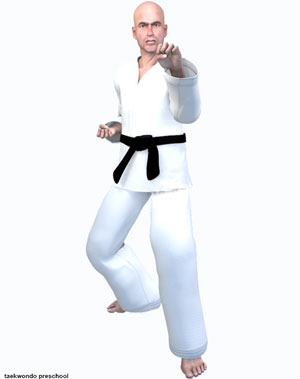
Back Stance ( 뒷굽이 dwi kubi ) is specifically focused on shifting weight to the back leg, as it offers much more control, and makes it easier to kick off the front leg. To perform the Back Stance ( 뒷굽이 dwi-kubi ), the body faces to the side, with the front foot facing forward and the front leg bent. The back leg is bent slightly and the foot is turned outwards perpendicular to the front foot making the letter "L" for this stance ( 서기 sogi ).
Question. What is the korean terminology for Back Stance?
Answer you gave was: ( 주춤서기 juchum sogi )
Your answer is wrong! You need to study more!
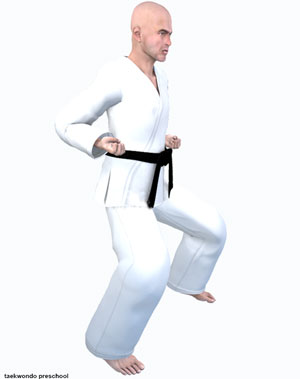
The Horse-Riding Stance ( 주춤서기 juchum-sogi ) is a beginner stance ( 서기 sogi ) generally used to practice punches ( 지르기 jireugi ) and blocks ( 막기 makgi ). It is similar to the Ready Stance ( 기본준비 junbi ) but the feet are placed much wider, about two-foot length's apart. Also, the knees ( 무릎 mureup ) are deeply bent and the shins ( 정강이 jeonggangi ) should be kept slightly perpendicular to the floor.
Question. What is the korean terminology for Back Stance?
Answer you gave was: ( 앞굽이 ap kubi )
Your answer is wrong! You need to study more!

Front Stance ( 앞굽이 ap-kubi ) is one of the most important techniques to learn when starting taekwondo as a beginner. The distance between the inside edges or namely the Reverse Foot Blade ( 발날등 balnaldeung ) of both feet should be between one to two fists apart and is about 4 to 4 one-half foot-length from origin. Rear toes are turned outward about 30 degrees and the body is also naturally angled at 30 degrees or facing straight forward depending on the upper body technique.
Question. What is the korean terminology for Back Stance?
Answer you gave was: ( 앞서기 ap sogi )
Your answer is wrong! You need to study more!

The Walking Stance ( 앞서기 ap-sogi ) is a beginner stance ( 서기 sogi ) that is used to approach or retreat in combat and patterns ( 품새 poomse ). Feet should be maintained approximately 3 foot-length from origin. To maintain a solid base, the front foot is facing straight forward and the back foot is 30 degrees to aid balance. Use of this stance ( 서기 sogi ) is featured prominently in many of the World Taekwondo (WT) Poomse.
There are five tenets defined in the International Taekwondo Federation (ITF) and several more in World Taekwondo (WT).
Indomitable spirit ( Baekjul Boolgool / 백절불굴 ): "To have indomitable spirit means to have the courage to stand up for what you believe in, no matter what odds you are up against, and to always give 100% effort in whatever you do." View Taekwondo Tenets »
RESOURCES
This article uses material from the Wikipedia article "List of Taekwondo Techniques", which is released under the Creative Commons Attribution-Share-Alike License 3.0.








